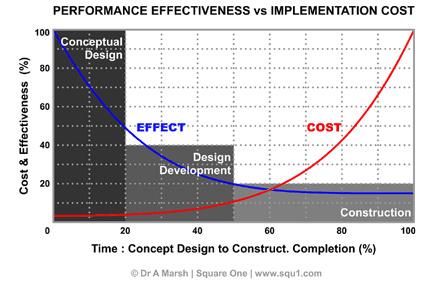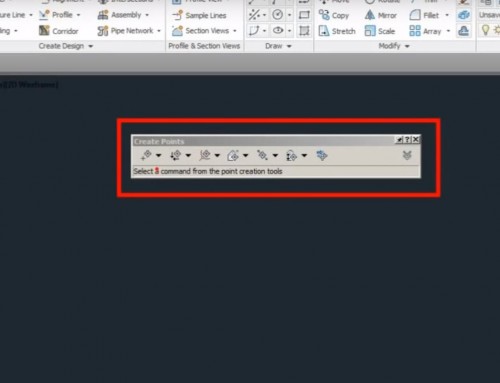Civil Applications of BIM
 The Architectural, Engineering, and Construction (AEC) industry is traditionally characterized as one that operates with abismal overhead costs, even though the process itself is a science; the lineal procedures tend to react in the most abstract forms, bringing unexpected changes to the execution of a project. Construction activity in the United States is averaging $629.43 billion dollars per quarter, meaning that this sector provides a lucrative base of clients eagerly looking to improve their profits, for software development companies. It is only natural that the IT industry turns its head to this sector with enormous areas of opportunities. Everything from conceptualization to construction and maintenance, this sector has proved that it can widely benefit from the use of software to improve the existing procedures.
The Architectural, Engineering, and Construction (AEC) industry is traditionally characterized as one that operates with abismal overhead costs, even though the process itself is a science; the lineal procedures tend to react in the most abstract forms, bringing unexpected changes to the execution of a project. Construction activity in the United States is averaging $629.43 billion dollars per quarter, meaning that this sector provides a lucrative base of clients eagerly looking to improve their profits, for software development companies. It is only natural that the IT industry turns its head to this sector with enormous areas of opportunities. Everything from conceptualization to construction and maintenance, this sector has proved that it can widely benefit from the use of software to improve the existing procedures.
As shown in the graph, construction activity continues to show a steady increase over the years and will continue to grow as predicted by the U.S. Bureau of Economic Analysis. This tendency will continue to impulse innovation in the AEC industry with new and better ways to plan, design, build, and maintain construction projects.
Following the principles of other industries, BIM was introduced to the AEC industry as a process that capitalizes on the advanced three dimensional visualization and parametric rich modeling of objects. This in turn, allows the early stages of the process to make important decisions over the design prior to reaching the construction phase, it is cheaper to erase a line than to demolish a wall. As illustrated in the following graph, we can observe that there is a direct correlation between time, effectiveness of changes and their cost.
 The more we are advanced in the project life cycle, the more expensive a change will become, additionally its effect will yield much less benefits. This is one of the main reasons why visualization is so important in the early stages of construction. Whether it is a building project or a civil project, the early visualization and availability of insights and information will continue to impulse a more sustainable model for project development.
The more we are advanced in the project life cycle, the more expensive a change will become, additionally its effect will yield much less benefits. This is one of the main reasons why visualization is so important in the early stages of construction. Whether it is a building project or a civil project, the early visualization and availability of insights and information will continue to impulse a more sustainable model for project development.
Specifically speaking of civil applications for BIM, the current software market offers highly competitive programs created to aid professionals in developing much more efficient designs, in less time, and at lower costs. This will make the infrastructure industry more sustainable in a sense that project costs will gradually become more competitive and allow civil engineers to propose higher impact designs.
BIM or Building Information Modeling is a process in which a digital model illustrates the physical and functional characteristics of a building in all stages of its life cycle. The earliest conception of BIM dates back to the birth of CAD, where some believed the ability to extract multiple views of a digital model, was an early concept of “Bidirectional Associativity”.
Today BIM goes beyond software, as we consider it a process, one that utilizes technology and collaboration for a successful project outcome. Even though software plays a big role in the early stages of a building project, it is not the essence of the process. Project teams now have the ability to work in a virtual world, replicating the traditional face-to-face relationship, from miles away. Technology allows true collaboration by eliminating the “distance challenge” and teams can have experts from all over the world working together.
Currently the use of 2D drafting tools is essential for both the public and private sectors of the AEC industry. These tools, as was intended over 30 years ago, aide in the drafting process of 2D drawings and details. However their purpose doesn’t resolve the additional requirements such as analysis, scheduling, spatial coordination, and possible future maintenance. Many of these tasks are left to the imagination or experience of the project designer.
The introduction of BIM to the AEC industry has been disruptive in a positive manner, introducing an entirely new culture of design, construction, and maintenance. What previously required separate procedures, now can be managed in one single process. This in itself presents many challenges as the industry is obligated to abide to new cultural ideologies in the workplace.
As part of the BIM revolution, collaboration has earned a new definition. Technology has enabled the collaborative process to reach new heights, it is now possible to connect specialists of different disciplines independently of their geographic location. This in itself brings new challenges, establishing a need for collaboration protocols and the resurgence of ideologies such as Integrated Project Delivery (IPD). IPD is a holistic approach to project delivery, establishing protocols that promote effective multidisciplinary collaboration. Additionally, IPD is known to drastically reduce errors in project development as all the information between parties is readily available to all stakeholders.
As for project management, the availability of three dimensional information, parametric data, and spatial coordination; BIM gives the Project Manager (PM) much more precise information to work with when planning the use of resources. In contrast, BIM will require the PM to consider more back end activities and costs to managing all the information that is being generated.
BIM is considered to work as a type of visual database, taking parametric data and reflecting a visual representation of a project. This parametric data is useful for creating schedules, quantities, and calculation data. The design and construction phases of the process can capitalize on this parametric data by offering highly accurate insights of project information. Cost analysis is also benefited by this information as the parametric data can provide a more accurate approximation of the actual cost of construction. Software such as Navisworks has implemented 5D and costs into its capabilities by merging the 3D geometry, project schedule, quantities, and prices.
In the civil engineering industry there currently are several attractive products on the market. Autodesk has a clear dominion over the market at the time, with products such as AutoCAD Civil 3D, Infraworks, Robot Structural Analysis, Revit, and Navisworks. While each has its own purpose, they all intertwine in the design and construction process. In the early phases of the design stage, conceptual planning and design, Infraworks proves to offer important insights to the initial stages of design. This software allows the designer to test horizontal and vertical geometry over satellite imagery, running the analysis of different corridor assemblies, getting highly accurate real-time results of earthworks and materials. It is important to note that this preliminary model is not for construction and only serves as a simulation model as satellite imagery does not provide accurate topo-surfaces.
Once a working preliminary model is built, this information can be exported to the Civil 3D environment for proper design. AutoCAD Civil 3D (C3D) allows designers to work with highly accurate 3D models created with field survey data. C3D works on a traditional workflow for civil works, with the exception of 3D toposurfaces and parametric horizontal and vertical designs that use bidirectional associativity to overlay that geometry over the 3D model. Some features that are included in C3D are surface creation tools, grading tools, parcel creation tools, horizontal and vertical geometry design, corridor creation tools, roundabout design tools, hydraulic design and calculation tools, and pipe design tools; these all capitalize on the use of 3D toposurfaces. Once design is complete, C3D exploits the power of AutoCAD for the creation of scaled printed drawings.
For design and development of construction documents of structures, the duo of Robot Structural Analysis and Revit can drastically improve this task. Robot Structural Analysis is a structural design and analysis software that has vast capabilities of running structural simulations and tests of different conditions. Additionally this software allows the designer to export a working model to Revit for further detailing and production of construction documents. Once in Revit, the designer can capitalize on the parametric data for takeoffs and quantification. The Revit model can be further coordinated with other design elements of the construction project.
The last piece of the puzzle is Navisworks, created as 3D spatial coordination software. Navisworks has continuously improved over the last years. Adding modules from extinct software, such as Quantity Takeoff, to further its capabilities. One of the most robust features is probably the interoperability of Navisworks with many formats, allowing project managers and designers to combine and coordinate 3D models from different platforms, even those that are not from Autodesk. For civil applications; 3D spatial coordination, 4D analysis, 5D analysis, and quantity takeoffs can be achieved.
Since its introduction, CAD has significantly improved the quality of drafting tasks. Eliminating some of the most common human errors from using traditional hand methods. This in itself has significantly improved the quality of drawings and furthermore the quality of design, aside from the fact that time was notably reduced as well as the cost of drawing supplies. CAD in its time was also positively disruptive to the industry as is the case now with BIM.
Software such as Revit and Civil 3D has introduced a new level of quality and drafting standards. The use of BIM ensures the accurate representation of an object in different perspectives. This capability reduces the possibility of errors and the amount of time invested when managing changes.
Working in a 3D environment also brings significant improvements to the quality of a project, both in design and construction. The application of BIM to civil applications can benefit from this 3D environment as important spatial aspects of the project can be anticipated. BIM has been known to be used in large industrial projects as coordination is key to reducing overhead costs caused by changes. When designing civil projects, the use of software such as AutoCAD Civil 3D, can improve the quality of design as a parametric model can reflect existing conditions as well as the proposed design. The application of BIM to civil structures can improve the quality of design and decision making as simulations can be run to test the design under different conditions.
The application of BIM is known to improve the project schedule in the later phases of the building lifecycle. Construction is commonly regarded as an activity that rarely stays on schedule or cost. Many activities are exceedingly underestimated with regards to time, the project manager depends on so many factors other than design to establish a realistic timeline. When a project is developed in BIM, the parametric data allows the construction team and PM to carefully plan each activity based on concrete facts. Software such as Navisworks allows the design and construction team to run accurate simulations of the project schedule, while linking the geometry to the timeline. This procedure gives the PM a visual representation of the construction process. Many times a project schedule may be flawed from its conception, so this analysis allows the PM to make adjustments as needed.
When a project schedule is created, the follow up of that schedule must be verified by comparing proposed vs real. Navisworks allows the PM to visually follow up on the project schedule and make adjustments as necessary.
Cost engineering is a science that requires a detailed eye for determining accurate expenditures. During the design stage, the designers must specify the details of the design to give the costs department a better idea of what is to be considered. The use of Navisworks can considerably help with the correct determination of quantities, allowing the costs engineers to more accurately quote construction activities.
These highly detailed quantity take offs and cost estimates will in turn be reflected in the construction phase of the project as it can significantly reduce overhead costs caused by changes or corrections. Additionally, the risk of encountering changes due to faulty coordination between disciplines is considerably diminished.
In conclusion, we can deduce that introduction of any technology to any industry brings along with it a disruption to work culture, processes and procedures, tools, and ideologies. This disruption is healthy for the AEC industry as it has brought a more competitive culture to planning, design, construction, and maintenance. Additionally it has created a much more collaborative environment where risk, responsibility, and reward are equally shared between collaborators. As for project management, information is always important to a successful project, the I in BIM provides insights to project managers for effectively planning projects.
With the use of tools like Infraworks, AutoCAD Civil 3D, Robot Structural Analysis, Revit, and Navisworks; civil engineers can further their capabilities, spending less time drafting and investing more time designing. Cost estimation and cost engineering can be highly benefited with the availability of accurate parametric data from the design to establish a much more realistic prediction of the base budget for any project. Overhead costs can be drastically diminished by reducing the amount of changes due to errors, omissions, or even simple drafting errors. Project schedules can be compacted to shorter and more effective timelines using the advanced visualization tools in Navisworks.
Interoperability continues to be an issue in 2019, with software companies still fighting to gain control of the AEC market, some bet on premise of offering software packets that do not play nice with other formats; thus obligating the consumer to purchase an entire line of software. This however is being faced with industry standards and exchange formats to enable streamlined collaboration regardless of brand with some minor limitations. In the end the consumer must decide on which brand or software line to choose based on features, usability, and most of all: productivity.

Leave A Comment